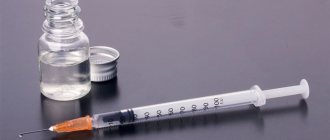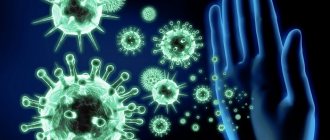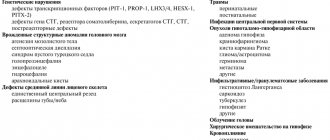Hypogonadism
Blackheads (acne)
Cervical cancer
23135 October 16
IMPORTANT!
The information in this section cannot be used for self-diagnosis and self-treatment.
In case of pain or other exacerbation of the disease, diagnostic tests should be prescribed only by the attending physician. To make a diagnosis and properly prescribe treatment, you should contact your doctor. We remind you that independent interpretation of the results is unacceptable; the information below is for reference only.
Testosterone: indications for use, rules for preparing for the test, interpretation of results and normal indicators.
Testosterone analysis: how to prepare
• Since physical activity stimulates the production of testosterone, you should avoid it the day before the test. This applies to intense sports and regular weight lifting. Smoking should also be avoided.
• For children and men, the test can be taken in the morning, on any day, for women - on the 6-7th day of the menstrual cycle (unless the attending physician has prescribed other dates for diagnostic purposes).
• The most favorable time to take blood for testing is from 8 to 11 am. A prerequisite is that blood is donated on an empty stomach, that is, after 8 and no more than 14 hours without food. You can only drink water.
How is low testosterone diagnosed?
If the urologist suspects low testosterone based on symptoms and physical examination, he or she will refer the patient for a testosterone test. This is the only way to confirm the diagnosis.
Most testosterone is bound to sex hormone binding protein and albumin. In young men, unbound testosterone (called free testosterone) is only about 2%. Due to the fact that measuring free testosterone is not accurate, it is preferable to test total testosterone levels (bound and free).
Testosterone test
Testosterone levels are best measured in the morning because the hormone follows a daily rhythm and reaches its highest value around 8:00 am.
Tests are also performed for other testosterone-stimulating hormones - LH (luteinizing hormone) and FSH (follicle-stimulating hormone). With their help, you can determine the primary or secondary cause of low testosterone levels.
Testosterone analysis explanation
Analysis for testosterone in men: the norm for men from 16 to 50 years old is 5.13 – 30.43 nmol/l. Testosterone levels in older men decrease and remain within the range of 5.4 – 19.5 nmol/l.
Testosterone analysis in women: the norm in women and girls from 13 years of age and throughout their reproductive years is between 0.36 and 1.97 nmol/l. During pregnancy, testosterone levels can be 3-4 times higher than normal. After menopause, the hormone level may decrease slightly and range from 0.28 to 1.22 nmol/l.
Testosterone analysis in children: the norm for boys in the first six months of life can vary from a minimum amount of 0.3 to a high concentration of 10.36 nmol/l. From 6 months to 9 years, testosterone levels usually remain stable below 1.24 nmol/L. For teenage boys, total testosterone is considered normal if it is below 15.41 nmol/L.
In girls under 13 years of age, testosterone levels usually do not exceed 0.98 nmol/l.
We must also remember that all people usually have hormone levels that fluctuate throughout the day: from the maximum value in the morning to the minimum in the evening.
All tests for testosterone should be interpreted by a doctor who takes into account not only the generally accepted average values of indicators, but also other factors that can affect the concentration of total testosterone in the blood.
Indications for prescribing the study
For boys, a blood test for testosterone is prescribed when:
- delayed puberty: lack of muscle mass, high-pitched voice, lack of body hair, small penis and testicles;
- premature maturation: the appearance before the age of 10 of a low voice, coarse hair on the body and face, acne, pronounced muscular structure.
For men and women, the analysis is indicated for low libido, infertility, and tumors of the gonads. Men need a test for reduced potency, chronic prostatitis, or suspected premature onset of male menopause.
In women, the study is most often performed for symptoms of increased androgen levels (hyperandrogenism):
- hair growth on the face and limbs, along the midline of the abdomen;
- lack of ovulation;
- dysfunctional uterine bleeding;
- insufficient development of the uterus and mammary glands;
- clitoral enlargement;
- polycystic ovary syndrome;
- miscarriage.
What causes increased testosterone?
• Adrenogenital syndrome provokes high testosterone in women;
• New growth of the testes increases testosterone in men;
• Disease or Itsenko-Cushing syndrome;
• A neoplasm in a woman’s ovaries, leading to the development of “masculinity” (deepening of the voice, a figure similar to a man’s, etc.);
• Decreased sex steroid binding globulin, or SHBG, in the blood;
• Excess and high intensity physical activity;
• The use of certain medications, such as levonorgestrel, mifepristone and various oral contraceptives, as well as tamoxifen, finasterine, danazol, phenytoin, etc.
What is testosterone
Testosterone is a sex hormone responsible for male characteristics.
It is considered one of the most powerful androgens in men and women. Testosterone formation occurs in the testicles, ovaries, and adrenal cortex. Its synthesis is stimulated and controlled by luteinizing hormone (LH), produced by feedback from the pituitary gland. As the concentration of testosterone increases, the concentration of LH decreases, and as the level of LH increases, the testosterone level decreases. Testosterone during fetal development determines the development of the male genital organs in the child: the penis, prostate and testicles. In a teenager, testosterone stimulates hair growth on the face and body, a deepening of the voice, muscle development, and enlargement of the penis and testicles.
In men of childbearing age, this hormone supports sexual desire and erection, and the formation of sperm. Testosterone in women is responsible for the maturation of the follicle during ovulation, ensures sexual desire and satisfaction with sexual life, muscle strength and bone strength, supports memory and cognitive functions of the brain.
Testosterone hormone in women - where does the danger lie?
Femininity does not mean that women should have no testosterone at all.
Everyone knows that excess testosterone in women causes masculinity, infertility, excess hair growth, as well as increased excitability and aggression. But low testosterone in women and men leads to decreased libido, physical weakness, hair loss, excess body weight, osteoporosis, atrophic changes in the skin, decreased mood, and even depression. Therefore, both high and low testosterone pose a danger to women’s health.
Having learned from your doctor about testosterone, how to increase its level, you can use simple methods that are available to everyone and approved by modern medicine.
How does testosterone deficiency manifest?
Testosterone deficiency in boys, which occurs before puberty, inhibits the formation and growth of the penis and testicles, and promotes enlargement of the mammary glands. In adolescents, there is insufficient facial and body hair, and later wet dreams and erections appear.
The main symptoms of testosterone deficiency in men:
- low sex drive;
- weak sexual activity;
- rare morning erections;
- insufficient erection during sexual intercourse.
Less specific signs:
- mood swings, depression;
- increased fatigue and irritability;
- insomnia;
- general weakness;
- male infertility;
- enlargement of the mammary glands;
- decrease in muscle mass;
- fat deposition around the internal organs and on the anterior abdominal wall (visceral and abdominal obesity);
- fractures due to minor trauma due to decreased bone density (osteoporosis);
- hot flashes;
- deterioration of memory, ability to concentrate.
Changes in the norm in women and what they are associated with
Natural changes in testosterone levels in the body occur in two cases: during ovulation and pregnancy. During ovulation, there is a sharp release of testosterone in the female body. This process increases sexual desire in women. At this time, the egg matures, thus the body makes it clear that it is ready to conceive.
During pregnancy, the amount of testosterone also changes. There is an increase in testosterone levels to a certain level. This is due to the fact that more energy is spent than usual to prepare the egg for conception, development and maturation of the fetus in the womb. An active increase in the hormone during pregnancy can be dangerous both for the development of the fetus and for the health of the expectant mother.
In addition to natural changes in testosterone levels, changes in testosterone levels can be caused by improper functioning of the body. Ovarian disease, poor functioning of the adrenal glands and some other endocrine system disorders provoke an excessive increase or decrease in testosterone.
An excess of testosterone indicates that it is time to check your endocrine system. You can notice a malfunction in the body by a number of signs:
- Failure of the menstrual cycle (absence or frequent periods two or three times a month);
- Unreasonable aggression, apathy, depression and melancholy;
- Change in voice, rough masculine notes appear;
- Increased hair growth;
- Breast reduction, body restructuring according to the male type;
- Negative changes on the skin of the face (the appearance of pimples and blackheads);
- Infertility
The other extreme is a lack of testosterone in the female body. At the same time, apathy, constant fatigue and loss of strength appear, the structure of the skin and hair changes. Low testosterone can lead to infertility in women.
In the first and second cases, you should immediately consult a doctor and get tested for the level of the hormone testosterone in the blood.
There may be several reasons for deviations from the norm. This is primarily due to physiological processes. This is influenced by several factors:
- Heredity and genes;
- Chronic diseases;
- Improper lifestyle and unbalanced diet;
- Taking contraceptive and hormonal medications;
- Ovarian tumor
- Pregnancy
The psychology of modern society can also cause an excess of testosterone. By engaging in purely masculine types of work and sports, refusing to bear children and procreate, a woman can cause some irreversible changes in her body. Hormones are closely related to a person’s mental state, so they will react accordingly.
Ban on free sale in pharmacies[edit | edit code]
Since August 16, 2014, a new list of drugs for subject-quantitative recording has been in effect in Russia.[5] Almost all injectable testosterone preparations are banned:
- "Testosterone propionate" (solution for intramuscular administration)
- "Andriol TK" (capsules)
- "Nebido" (testosterone undecanoate solution for intramuscular administration)
- "Sustanon-250" (solution for intramuscular administration)
- "Omnadren-250" (solution for intramuscular administration).
Interesting facts[edit | edit code]
A study by French scientists showed that men who eat spicy foods have higher testosterone levels, and therefore increased sexual activity. The results of the work are presented in the journal Physiology & Behavior.[6]
A study[7] conducted on 1113 men showed that marital status plays an important role in a man’s hormonal background. Testosterone decreases significantly after marriage. This is associated with the evolutionary mechanism of limiting the search activity of a new partner and greater commitment to the family.
Sources[edit | edit code]
- Breiner M, Romalo G, Schweikert HU (Aug 1986). "Inhibition of androgen receptor binding by natural and synthetic steroids in cultured human genital skin fibroblasts." Klinische Wochenschrift. 64 (16): 732–37.
- Kelly MJ, Qiu J, Rønnekleiv OK (2005-01-01). "Estrogen signaling in the hypothalamus". Vitamins and Hormones. 71: 123–45. doi:10.1016/S0083-6729(05)71005-0. PMID 16112267.
- https://jem.rupress.org/content/early/2017/05/05/jem.20161807
- https://www.ncbi.nlm.nih.gov/pubmed/11701431
- Letter of the Ministry of Health of Russia dated 09/03/2014 N 25-4/10/2-6691 “On the implementation of substantive and quantitative accounting of medicines”
- https://time.com/3633813/spicy-food-testosterone/
- https://www.ncbi.nlm.nih.gov/pubmed/28376340
Preparation for the procedure
You need to prepare for a testosterone test.
- The material is collected in the morning, on an empty stomach. The last meal should take place no earlier than eight hours before the visit to the treatment room.
- Alcohol should not be consumed during the seven days preceding the test.
- Two weeks before donating blood, you must stop taking medications. If this cannot be done, the dose and name of the drug that was taken are indicated on the referral.
- A few days before the examination, doctors recommend limiting physical activity and avoiding sexual intercourse.
- On the eve of handing over the material, you should not consume large amounts of salt, overeat meat, sweets and baked goods.
- Smoking is prohibited for eight hours prior to the test.
Failure to follow the preparation rules greatly increases the likelihood of a false result.
How is the analysis carried out?
Blood is drawn from a vein. There are many ways to determine the level of free testosterone in the blood. In practice, radioimmunoassay is most often used, but it is considered not very accurate. Its use is determined by the low cost of the entire process.
Currently, the most accurate way to calculate testosterone levels in the blood is the double dialysis and ultracentrifugation method. But due to its high cost and labor intensity, it is used extremely rarely.







